Hoy salí muy temprano a retirar unos resultados de solicitudes de laboratorio, en el Hospital Perón. Se trata del que frecuento algunas veces, para mis chequeos de salud. Luego de esta aclaratoria, les muestro lo hermoso del Ceibo que una vez abracé y que aún no tenía esos hermosos racimos de flores. El ceibo en cuestión, es nombrado popularmente como “Ceibo Anahí”, debido a una hermosa leyenda guaraní, que les explicaré, al finalizar la serie de fotografías correspondientes.
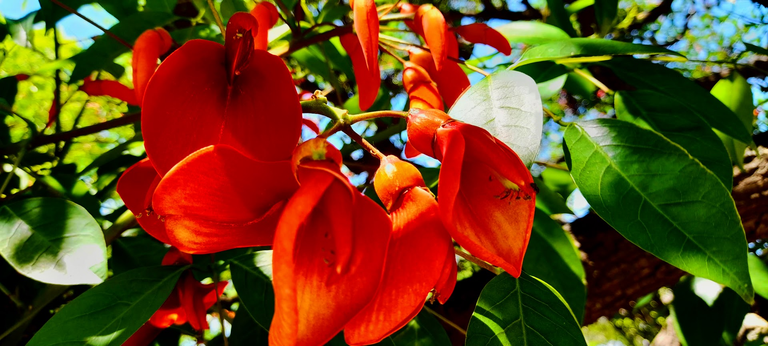
La verdad es que cuando me acerqué a mirar los racimos de flores rojas, recordé que también esta especie de ceibo, existe en mi país, Venezuela. Recolectaba sus flores, para ponérmelas en mi cabello cuando era una niña y adolescente, pues ese rojo intenso que tienen, obnubila los sentidos del afortunado que las pueda mirar muy de cerca.

Eso me ocurrió hoy en la mañana. Había un sol radiante, por lo que buscaba una sombra para refrescarme un poco, antes de regresar a casa. Cuando me senté en el banco de concreto y mire hacia arriba, se despertó en mi interior, el deseo de perpetuar las hermosas imágenes que observé, y por supuesto compartiré con todos.
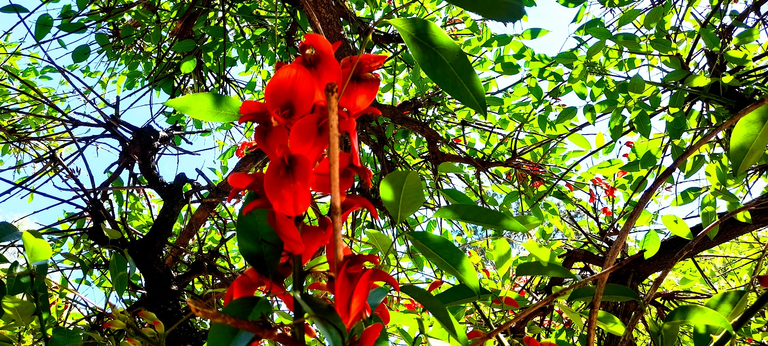
El Ceibo, también tiene la fortuna de ser el Árbol nacional de dos países vecinos, Argentina y de Uruguay, así como comparten otros símbolos, por ser países hermanos. Igualmente, en otros países este árbol, es nombrado, Bucare, y/o Gallito, por el parecido de sus flores, cuando están por abrir, a un pico de gallo o una espuela. Asimismo, le llaman seibo o seíbo, escrito con la "S".
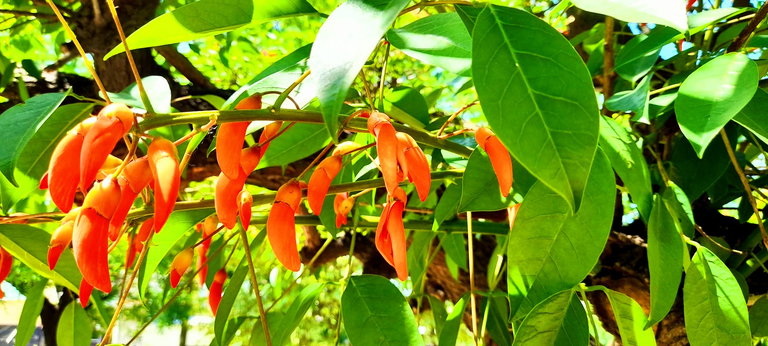
Al alzar la cabeza hacia la copa interior del Bucare, me percaté de que, de su corto tallo, se desprenden ramajes en diversas direcciones. La razón radica en que cada otoño, cuando se inicia la caída de sus hojas, los encargados del mantenimiento de los jardines realizan una gran poda. No obstante, debido a esos magníficos racimos, este ceibo, ofrece una amplia sombra gracias a esos espléndidos racimos
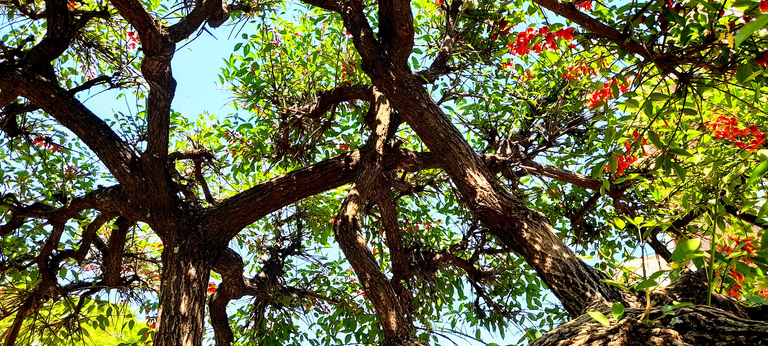
A continuación se muestra el grosor de su tronco, visible desde su interior. Se aprecia que el árbol recibe cuidados, ya que integra la belleza natural que adorna y rodea al Hospital Perón. En sus ramas, junto a las horquetas, se escuchan frecuentemente los nidos de pájaros, dado que, en caso de estar sentado en el banco, de concreto o bien en una proximidad cercana, se percibe el silbar de los pichones. Los pacientes, cuando están a la espera de algún documento o las familias de los que están hospitalizados, aprovechan de bajar para descansar bajo los frondosos árboles y bancos que ofrece este lugar.
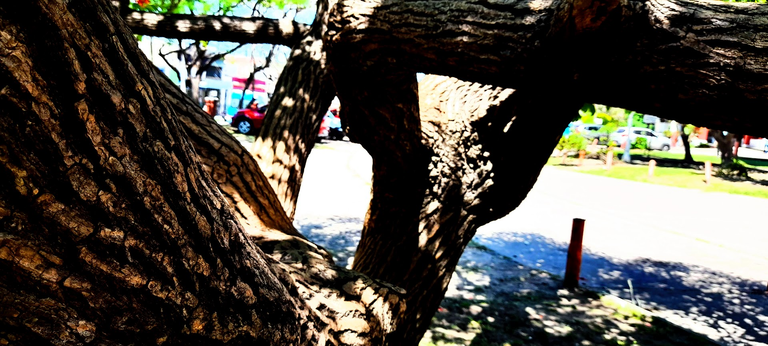
La flor del Ceibo, es elegida, por su belleza, y porque en casi todo el país, se hace presente con su ramaje y floración tan única. Entre otras características, el hermoso color de esta flor, está plasmado como parte importante del Escudo de la Nación. Esto también la hace aparecer como árbol nacional en el mundo. Esta decisión, por supuesto, forma parte de las Leyes del País. Que, por otra parte, no existe en la República una flor que encierre características botánicas, fitogeografías, artísticas o históricas que hayan merecido la unanimidad de las opiniones para asignarle jerarquía de flor nacional, por lo que las predilecciones, como se ha puesto de manifiesto en las encuestas y concursos llevados a cabo.
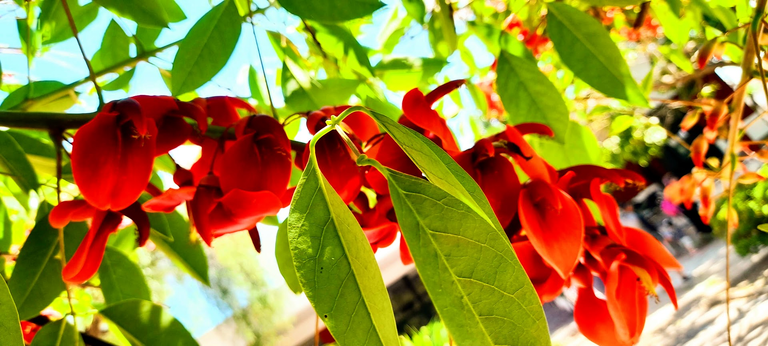
Un dato curioso, y que llamó mi atención entre los secretos de la flor del Ceibo, «Anahí», fue que su nombre surge debido a una Leyenda Guaraní. Esta narración tuvo lugar en la época de descubrimiento, en las orillas del Río Paraná.
La narrativa narra que la India Anahí, aunque era fea, tenía una voz como los dioses, y experimentaba una gran alegría al abrazar su libertad y vivir en su grupo, hasta que llegaron los colonos y los pusieron en cautiverio.
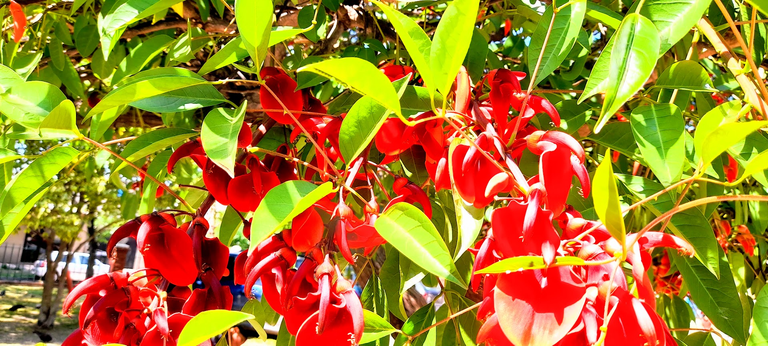
Anahí logró escaparse una noche, pero un carcelero la halló y ella se defendió clavando un cuchillo en su pecho. Una vez que el crimen fue descubierto, los soldados la persiguieron, hasta atraparla, y atarla justo en el tronco de un ceibo. La condenaron a la muerte en el fuego. Mientras que su cuerpo se encontraba abrazado por las llamas, no pronunció ninguna palabra, permaneció en silencio. Al día siguiente los soldados quedaron asombrados, porque donde fue quemada Anahí la noche anterior, había un hermoso árbol lleno de flores. Así que de allí viene el nombre de esta inigualable flor.
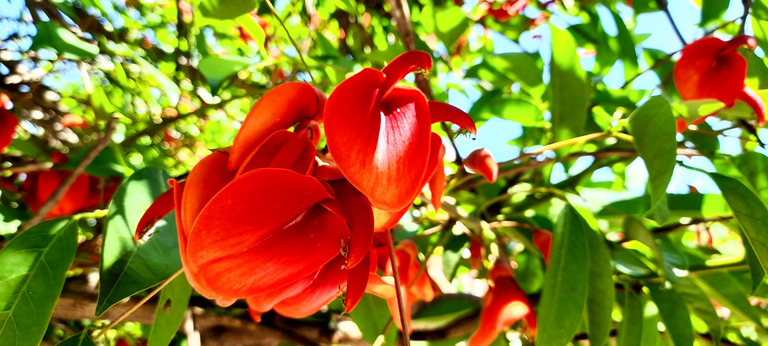
Letra de la canción Anahí
Anahí
Las arpas dolientes
hoy lloran arpegios
que son para ti
Anahí
recuerdan acaso
tu inmensa bravura
reina guaraní
Anahí
indiecita fea
de la voz tan dulce
como el aguaí
Anahí... Anahí
tu raza no ha muerto
perduran tus fueros
en la flor rubí
Defendiendo altiva
tu indómita tribu
fuiste prisionera
condenada a muerte
ya estaba tu cuerpo
envuelto en la hoguera
en tanto las llamas
la estaban quemando
en roja corona
se fue transformando
la noche piadosa
Cubrió su dolor
y el alba asombrada
miró tu martirio,
hecho ceibo en flor
Anahí
Las arpas dolientes
hoy lloran arpegios
que son para ti
Anahí
Recuerdan acaso
tu inmensa bravura
reina guaraní
Anahí
Indiecita fea
de la voz tan dulce
como el aguaí
Anahí… Anahí
Tu raza no ha muerto
perduran tus fueros
en la flor rubí...
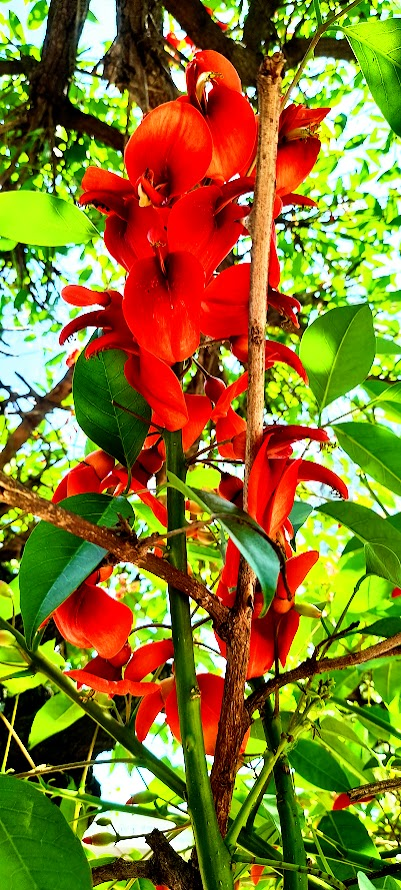
Seguidamente, les compartiré la canción que, en honor a la leyenda de la india “Anahí”, compuso el argentino Osvaldo Sosa Cordero. Recomiendo que escuchen esta leyenda Guaraní, que, entre otras cosas, causales, dos países la eligen como “La Flor Nacional” Ellos son: Argentina y Uruguay.
Traducción al Inglés
I went out very early today to pick up some lab results at the Peron Hospital. This is the one I go to sometimes, for my health check-ups. After this clarification, I show you the beauty of the Ceibo tree that I once embraced and that still did not have those beautiful clusters of flowers. The Ceibo in question is popularly called “Ceibo Anahi”, due to a beautiful Guarani legend, which I will explain at the end of the series of photographs.

The truth is that when I approached to look at the clusters of red flowers, I remembered that this species of ceibo also exists in my country, Venezuela. I used to collect its flowers to put them in my hair when I was a child and teenager, because their intense red color dazzles the senses of the lucky person who can look at them very closely.

That happened to me this morning. The sun was shining brightly, so I was looking for some shade to cool off a bit before heading home. When I sat down on the concrete bench and looked up, the desire to perpetuate the beautiful images I observed, and of course will share with everyone, was awakened within me.

The Ceibo also has the fortune of being the national tree of two neighboring countries, Argentina and Uruguay, as well as sharing other symbols, as they are brother countries. Likewise, in other countries this tree is called Bucare, and/or Gallito, because of the resemblance of its flowers, when they are about to open, to a rooster's beak or a spur. Also, it is called seibo or seibo, written with the “S”.

As I raised my head towards the inner canopy of the Bucare, I noticed that branches are coming off its short stem in different directions. The reason is that every autumn, when the leaves begin to fall, the garden maintenance workers carry out a major pruning. However, because of those magnificent clusters, this ceibo offers ample shade thanks to those splendid clusters.

The thickness of its trunk, visible from the inside, is shown below. It can be seen that the tree is cared for, as it is part of the natural beauty that adorns and surrounds the Perón Hospital. In its branches, next to the forks, the birds' nests are frequently heard, since, in case of sitting on the bench, made of concrete or in a close proximity, the whistling of the chicks can be heard. Patients, when they are waiting for a document or the families of those who are hospitalized, take the opportunity to go down to rest under the leafy trees and benches that this place offers.

The Ceibo flower is chosen for its beauty, and because it is present almost everywhere in the country with its unique branches and flowers. Among other characteristics, the beautiful color of this flower, is captured as an important part of the Coat of Arms of the Nation. This also makes it appear as a national tree in the world. This decision, of course, is part of the Laws of the Country. That, on the other hand, there is no flower in the Republic that contains botanical, phytogeographical, artistic or historical characteristics that have deserved the unanimity of opinions to assign it hierarchy of national flower, so the predilections, as it has been shown in the surveys and contests carried out

A curious fact that caught my attention among the secrets of the Ceibo flower, “Anahi”, was that its name comes from a Guarani legend. This story took place at the time of discovery, on the banks of the Paraná River.
The narrative tells that the Anahi Indian, although ugly, had a voice like the gods, and experienced great joy in embracing her freedom and living in her group, until the colonists arrived and put them in captivity.

Anahí managed to escape one night, but a jailer found her and she defended herself by plunging a knife into his chest. Once the crime was discovered, the soldiers chased her until they caught her and tied her to the trunk of a ceibo tree. They condemned her to death by fire. While her body was embraced by the flames, she did not utter a word, she remained silent. The next day the soldiers were astonished, because where Anahi was burned the night before, there was a beautiful tree full of flowers. So that is where the name of this unique flower comes from.

Song lyrics Anahí
Anahi
The mourning harps
today cry arpeggios
that are for you
Anahi
perhaps they remember
your immense bravery
Guarani queen
Anahi
ugly little Indian girl
with a voice as sweet
as sweet as water
Anahi... Anahi
your race is not dead
your strength lives on
in the ruby flower
Defending haughtily
your untamed tribe
you were a prisoner
condemned to death
your body was already
wrapped in the bonfire
while the flames
were burning it
in red crown
it was transforming
the pious night
covered her pain
and the astonished dawn
watched your martyrdom,
made ceibo in flower
Anahi
The mourning harps
today cry arpeggios
that are for you
Anahi
Perhaps they remember
your immense bravery
Guarani queen
Anahi
Ugly little Indian
with a voice as sweet
as sweet as water
Anahi... Anahi
Your race is not dead
your strength lives on
in the ruby flower...

Next, I will share with you the song that, in honor of the Indian legend “Anahi”, composed by the Argentine Osvaldo Sosa Cordero. I recommend that you listen to this Guarani legend, which, among other causal things, two countries choose it as “The National Flower” They are: Argentina and Uruguay.
Las fotografías publicadas, son de mi propiedad, capturadas con mi Samsung A-12.
The photographs published are my own, captured with my Samsung A-12.
Traductor
X